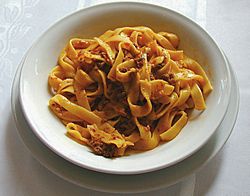Ragù facts for kids

Tagliatelle al ragù bolognese
|
|
| Type | Sauce |
|---|---|
| Place of origin | Italy |
| Main ingredients | Meat, vegetables |
| Variations | Bolognese sauce, Neapolitan ragù |
Ragù is a yummy meat-based sauce from Italy. People usually eat it with pasta. It's a very popular dish in Italian cuisine.
An Italian food group, Accademia Italiana della Cucina, has written down many ragù recipes. All these recipes share two main things: they contain meat and they are sauces for pasta.
The most famous type is ragù alla bolognese, also known as Bolognese sauce. Other kinds include ragù alla napoletana (Neapolitan ragù) and ragù alla barese.
Contents
Different Kinds of Ragù
The way ragù is made can be different depending on where you are in Italy.
Northern Italian Ragù
In northern Italy, ragù often uses meat that is cut into very small pieces. This can be minced, chopped, or ground meat. It's cooked with vegetables that have been lightly fried, called sautéed vegetables.
The meat is cooked in a liquid. This liquid can be broth, water, wine, milk, or even cream. Sometimes, a little bit of tomato is added too. The important thing is that the sauce is mostly about the meat, not the tomatoes.
Many different meats can be used. These include beef, chicken, pork, duck, goose, lamb, or veal.
Southern Italian Ragù
In southern Italy, ragù is often made with bigger pieces of meat. These can be large cuts of beef or pork. Sometimes, local sausages are also added.
These meats are cooked slowly with vegetables and tomatoes. This slow cooking is called braising or simmering. After cooking for a long time, the meat is often taken out. It can then be served as a separate meal, without the pasta.
Examples of these dishes are ragù alla Napoletana and carne al ragù.
Where Ragù Comes From
The word "ragù" comes from the French word ragoût. This word arrived in Italy in the late 1700s. It might have come after Napoleon's army entered northern Italy in 1796.
Before this time, Italian cooking already had many meat stews. These stews had been around since the Renaissance period. However, they were not called ragù. Also, people didn't usually eat them with pasta.
For a long time, pasta was often cooked in meat broth, like a simple soup. The meat was then taken out and eaten separately.
The First Ragù Recipe
The first time a meat sauce was officially recorded as being served with pasta was in the late 1700s. This first ragù recipe was called ragù per i maccheroni.
It was created by Alberto Alvisi, who was a cook for the Cardinal of Imola. At that time, "maccheroni" was a general word for all kinds of pasta. This recipe was later published and became known as Il Ragù del Cardinale (The Cardinal's Ragù).
Ragù Becomes Popular
After the early 1830s, more and more ragù recipes started appearing in cookbooks. These books were mostly from the Emilia-Romagna region of Italy.
By the late 1800s, meat was quite expensive. So, rich meat sauces like ragù were mostly eaten on special days. These included feast days and Sundays, and only by wealthier families.
Later, new technologies from the Industrial Revolution made pasta flour cheaper. This meant more people could afford pasta. After World War II, Italy's economy grew, and pasta became even more common. Before the war, many people in the countryside ate mostly plants. Pasta was saved for special occasions and often served in a soup with beans.
See also
 In Spanish: Ragú para niños
In Spanish: Ragú para niños

